If you’re looking to add a touch of natural beauty and color to your garden, wildflowers are the perfect addition. Not only do they require minimal maintenance, but they also attract pollinators such as bees and butterflies. In this article, we’ll explore ten different wildflower species that will thrive in your garden and bring new life to your outdoor space. From delicate bluebells to vibrant poppies, these flowers will not only look stunning but also contribute to the health of local ecosystems. Whether you’re an experienced gardener or just starting out, get ready for some inspiration on how to fill out your garden with these ten gorgeous wildflowers.
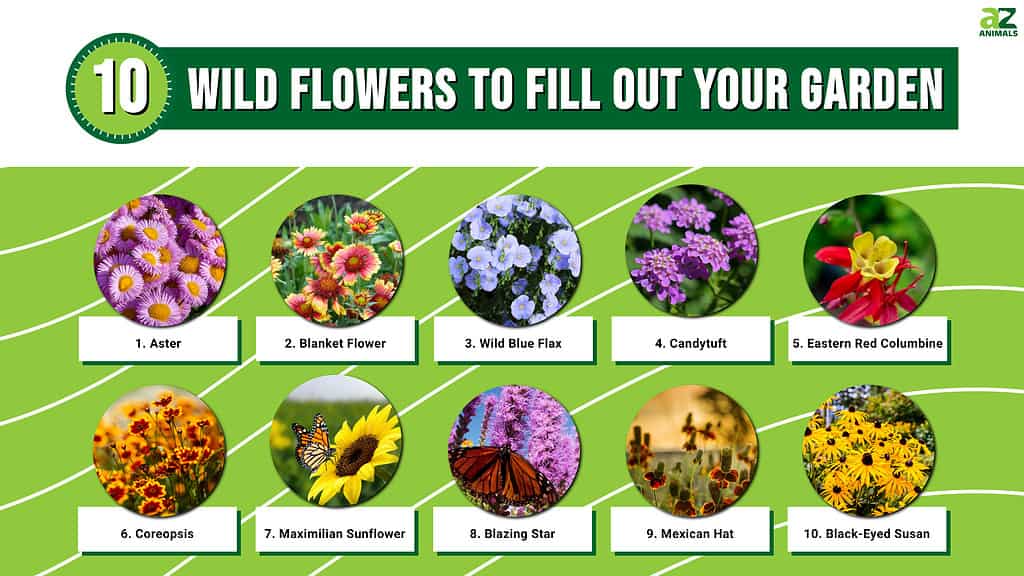
1. Aster
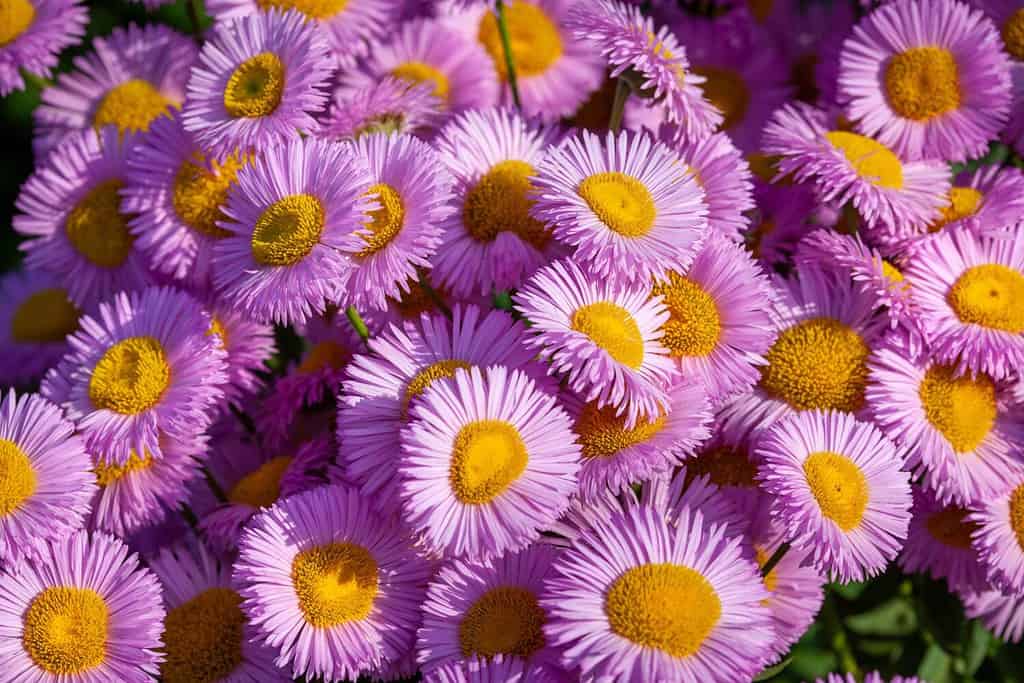
Asters are easy-to-grow flowers for a pop of fall color in the garden.
©Klever_ok/Shutterstock.com
Aster (Symphyotrichum oblongifolium) is a great addition to any wildflower garden. This plant species typically produce beautiful blooms in late summer or early fall, making it an excellent choice for adding color and interest to your outdoor space during the latter part of the growing season.
One of the primary benefits of incorporating aster into your garden is that it attracts pollinators such as bees, butterflies, and hummingbirds. These creatures are essential for maintaining healthy ecosystems and supporting biodiversity by aiding in cross-pollination.
Additionally, aster is relatively low-maintenance once established and can grow well even in poor soil conditions. It prefers full sun exposure but can tolerate some shade if necessary. The plant also has a long lifespan compared to other annual flowers, with some cultivars living up to ten years or more.
Overall, if you’re looking for an attractive perennial flower that’s easy to care for and offers significant ecological benefits, consider adding aster (Symphyotrichum oblongifolium) to your wildflower garden this year!
2. Blanket Flower
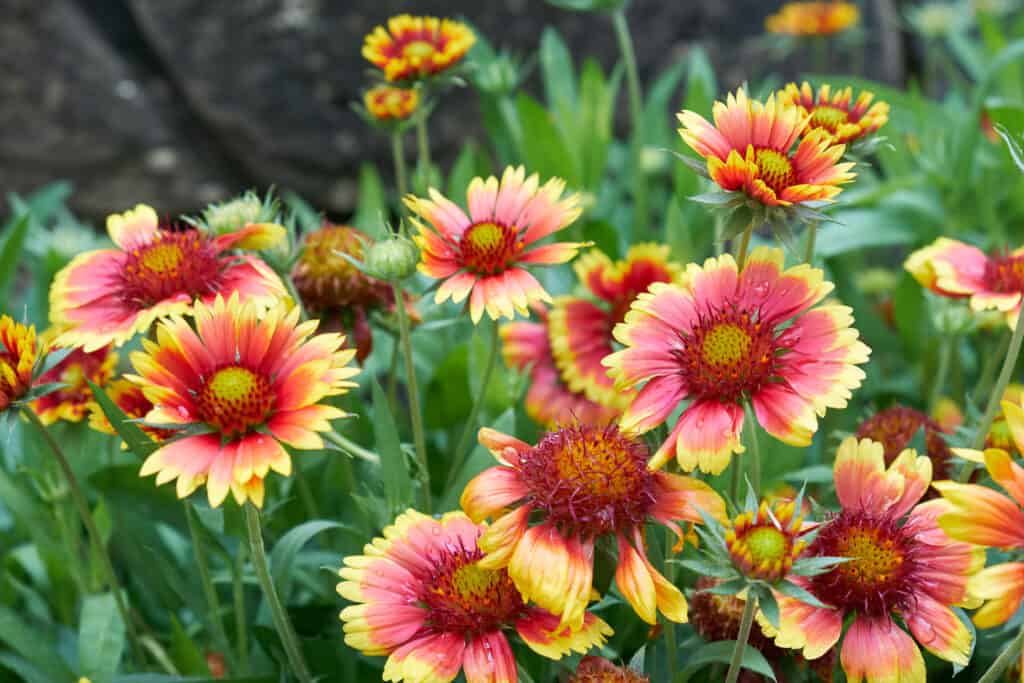
There are many varieties and cultivars of blanket flowers to choose from.
©iStock.com/Iseo Yang
Blanket flower, also known by its scientific name Gaillardia aristata, is a beautiful and hardy plant that is perfect for filling out your garden with vibrant colors. This wildflower native to North America can grow up to two feet tall and has distinctive daisy-like flowers with red or yellow petals radiating from the center disk.
One of the most appealing aspects of blanket flowers is their ability to attract pollinators such as bees and butterflies. In fact, planting blanket flowers alongside other nectar-rich plants can create a veritable haven for these important insects.
In terms of care requirements, blanket flowers are relatively low-maintenance. They prefer full sun and well-drained soil but can tolerate some drought conditions once established. Deadheading spent blooms will encourage continued blooming throughout the growing season.
Overall, if you’re looking for an easy-to-grow wildflower that adds vibrant color and attracts pollinators to your garden, blanket flowers may be just what you need!
3. Wild Blue Flax

Blue flax is a beautiful blue wildflower.
©iStock.com/Marcasia
Wild blue flax, also known by its scientific name Linum perenne var. lewisii, is a stunning wildflower that can add a touch of natural beauty to any garden. As the name suggests, this flower has vibrant blue petals that are sure to catch the eye.
One interesting fact about wild blue flax is that it is native to North America and was used extensively by indigenous peoples for both medicinal and practical purposes. For example, some tribes would use the stems of the plant to make cordage or baskets, while others brewed tea from the leaves as a remedy for various ailments.
In terms of growing conditions, wild blue flax prefers full sun and well-drained soil. It can be grown in a variety of settings, including meadows, rock gardens, or even containers. While it may not bloom as profusely in areas with heavy shade or clay soils, with proper care, it should still thrive.
Overall, whether you’re an experienced gardener looking to add some unique flora to your collection or simply someone who appreciates the beauty of nature’s creations, wild blue flax is definitely worth considering!
4. Candytuft
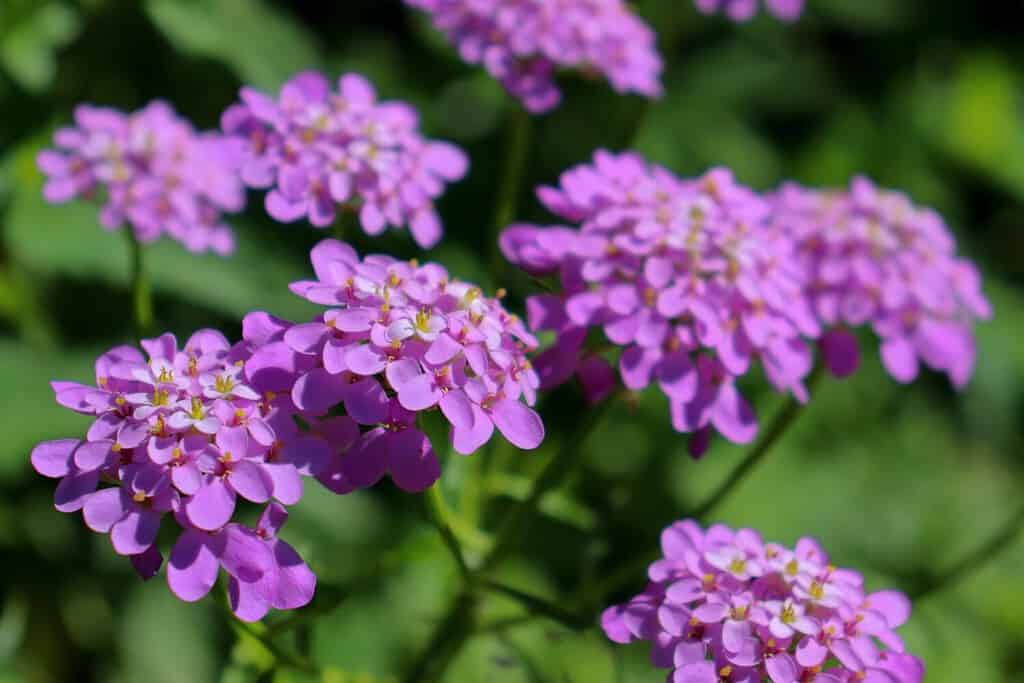
Candytuft comes in lavender, pink, purple, or white.
©AGabriel_Photo/Shutterstock.com
Also known as Iberis umbellata, candytuft is a beautiful and delicate flowering plant that belongs to the family Brassicaceae. It is native to Europe but has become popular in many parts of the world due to its stunning beauty and ease of cultivation.
This lovely flower comes in various colors ranging from white, pink, lavender, and purple. It produces small flowers with four petals that grow into clusters on top of long stems. Candytuft blooms mainly during springtime but can continue blooming sporadically throughout summer, depending on climate conditions.
One fascinating characteristic of candytuft is its ability to attract pollinators such as bees and butterflies due to its sweet fragrance. Gardeners often use this feature when planting candytufts alongside other plants that require cross-pollination.
Cultivating candytuft requires minimal effort since it thrives best in well-drained soil under full sunlight exposure. Additionally, this versatile plant adapts perfectly to different garden settings, such as rock gardens or border edges.
In conclusion, if you are looking for an easy-to-grow yet breathtakingly beautiful flower for your garden or landscape project, then Iberis umbellata (candytuft) should be at the top of your list!
5. Eastern Red Columbine
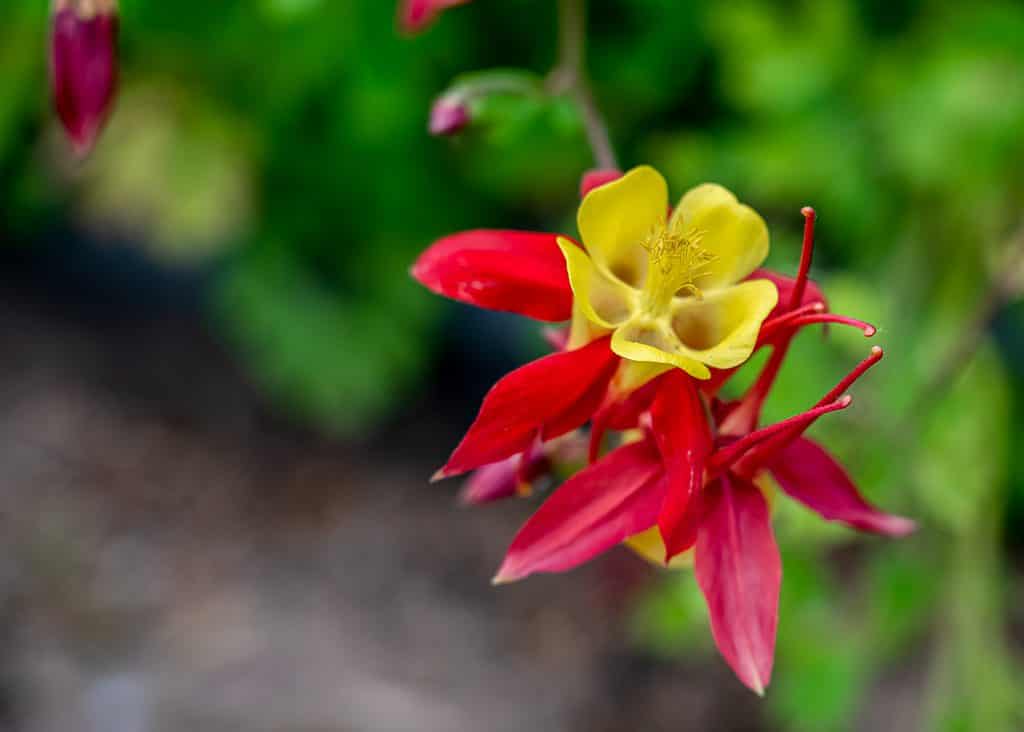
There are dozens of different columbines to choose from, each more beautiful than the last.
©Martin Hibberd/Shutterstock.com
Eastern red columbine, also known as Aqualegia conadensis, is a stunning and unique wildflower that belongs to the buttercup family. This flower is native to eastern North America and can be found from Canada down to Florida. Its vibrant red color makes it a popular choice for gardeners who want to add some boldness and drama to their floral displays.
The eastern red columbine typically grows up to 2 feet tall with delicate-looking stems adorned by intricate flowers that resemble tiny lanterns or bells. Each stem bears several nodding blossoms with five distinctive petals that flare outwards in shades of deep crimson red or pink hues. The inner part of the flower contains yellow stamens, which add contrast and interest.
Additionally, the nectar-rich blooms attract hummingbirds, bees, butterflies, and other pollinators, making them an essential component for any wildlife-friendly garden.
Overall, Eastern Red Columbine is a magnificent wildflower well worth considering if you are looking for something unique yet beautiful for your garden display!
6. Coreopsis
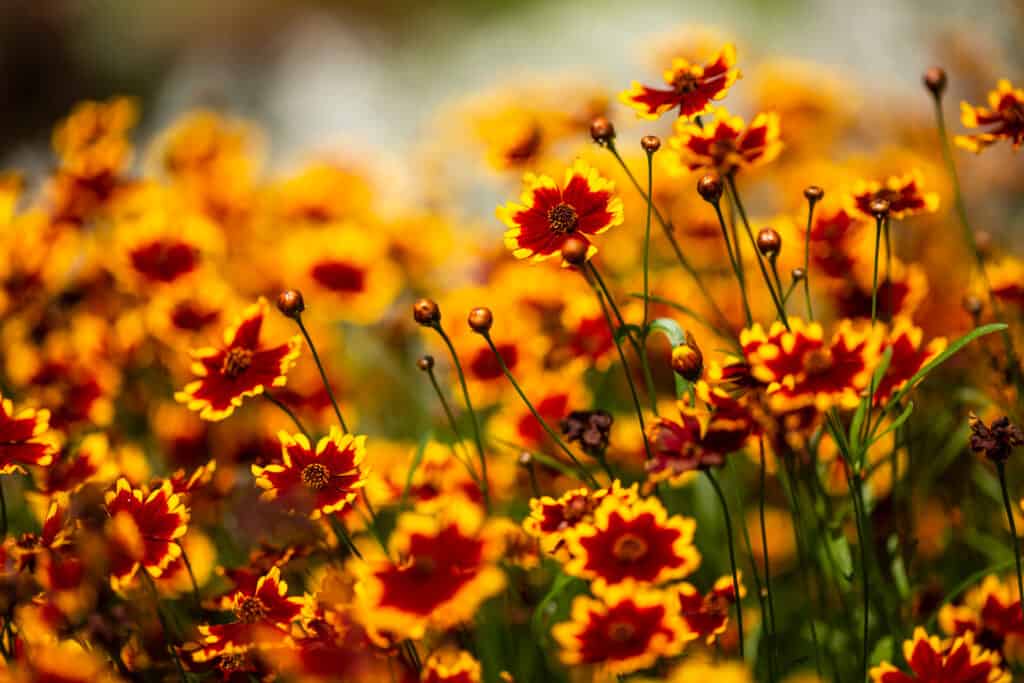
Coreopsis plants are easy to care for.
©RuthG/Shutterstock.com
Also known as tickseed, Coreopsis is a beautiful perennial plant that belongs to the Asteraceae family. It is native to North America and can be found in various habitats such as open fields, prairies, and along roadsides. The lanceolate leaves of coreopsis grow up to 4 inches long and are arranged in pairs on the stem.
The most striking feature of this plant is its bright yellow flowers which have a distinctive daisy-like appearance with 8-10 petals surrounding a small center disk. These flowers bloom profusely from spring through summer, attracting bees, butterflies, and other pollinators to your garden.
Coreopsis plants are easy to grow and maintain, making them an excellent choice for beginner gardeners. They prefer well-drained soil with full sun exposure but can tolerate some shade. Once established, they are quite drought tolerant requiring minimal watering.
Overall, adding coreopsis plants to your garden will not only enhance its beauty but also support local ecosystems by providing nectar sources for pollinators.
7. Maximilian Sunflower
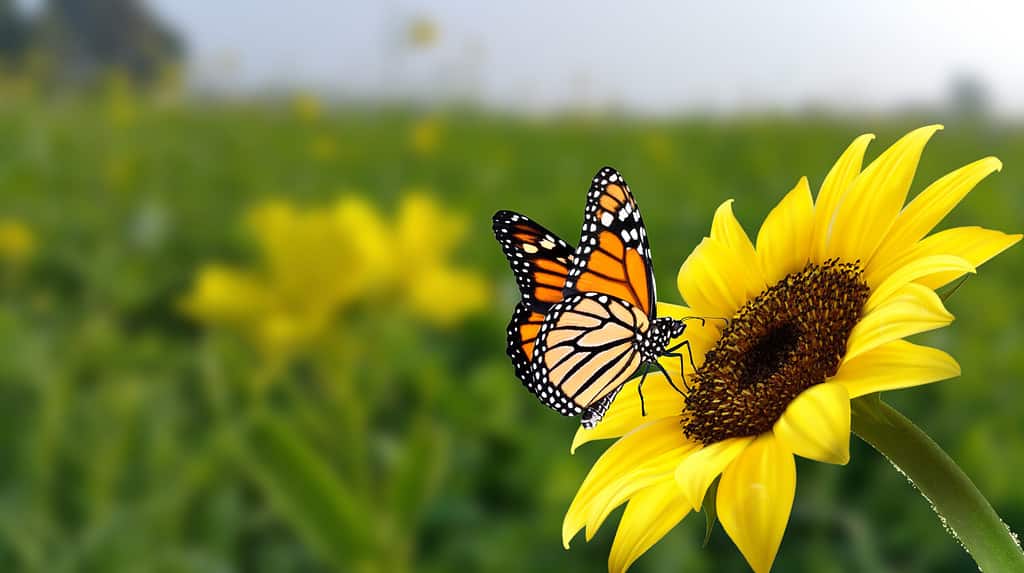
Wild sunflowers are a favorite with butterflies and birds.
©Candy_Plus/Shutterstock.com
The Maximilian sunflower, also known by its scientific name Helianthus maximiliani, is a tall and stately perennial flower that belongs to the Asteraceae family. Native to North America, this plant can reach up to 10 feet in height with a spread of approximately 3-4 feet.
One of the defining features of the Maximilian sunflower is its numerous bright yellow petals that surround a dark center disk. The flowers bloom during late summer and early fall and attract an array of pollinators such as bees, butterflies, and birds.
This plant thrives in full sunlight and well-drained soil but can tolerate some shade as well. It requires moderate watering during dry spells but is otherwise relatively low maintenance. The Maximilian sunflower has been known to self-seed readily if left unattended, making it an excellent option for naturalizing areas or adding a pop of color to wild gardens.
In addition to their aesthetic appeal, these plants are also valued for their ecological benefits. They provide food sources for various wildlife species and have been used medicinally by indigenous communities throughout history.
Overall, the Maximilian sunflower is a stunning addition to any garden or landscape setting that offers both beauty and environmental value.
8. Blazing Star

While blazing star doesn’t take up much space, it still provides a significant amount of nectar for butterflies.
©Media Marketing/Shutterstock.com
Blazing star, also known by its scientific name Liatris spicata, is a beautiful wildflower that can add vibrancy and color to any garden. This stunning plant is native to North America and belongs to the Asteraceae family. It typically grows in tall spikes with vibrant purple or white flowers arranged in a dense, cylindrical shape.
In terms of its physical appearance, the blazing star stands out due to its long stems and grass-like leaves at the base. Its flowers bloom from mid-summer through early fall, making it an excellent choice for those looking for late-season interest in their gardens.
Beyond its aesthetic appeal, the blazing star serves as an important source of nectar for pollinators such as bees and butterflies. It’s also relatively easy to care for as it prefers full sun exposure but can tolerate partial shade.
Overall, if you are on the hunt for a visually striking yet low-maintenance addition to your garden that will attract beneficial insects like butterflies while providing color well into the fall season – look no further than a blazing star!
9. Mexican Hat
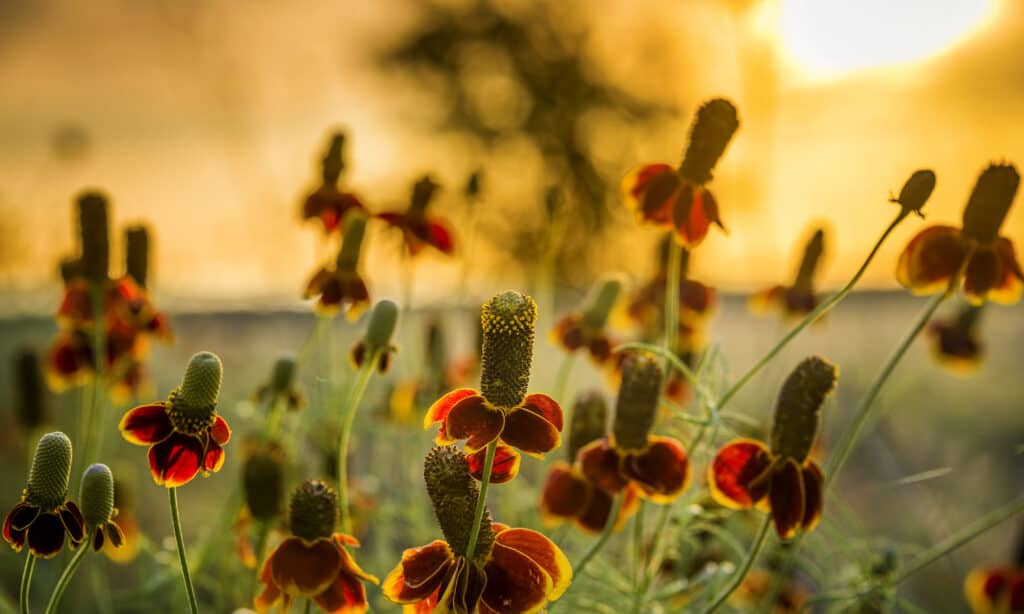
These wildflowers look like tiny hats.
©Dean Fikar/Shutterstock.com
Mexican hat flower, also known as Ratibida columnifera, is a beautiful and unique wildflower that can add a touch of whimsy to any garden. This plant is native to North America and can be found in fields, meadows, and prairies across the continent.
The Mexican hat flower gets its name from its distinctive shape – it looks like a tiny sombrero! The center of the flower forms a tall column or cone that is surrounded by drooping petals in shades of yellow, orange, and red. The flowers bloom from June to September and attract bees, butterflies, and other pollinators.
One of the great things about this wildflower is how easy it is to grow. Mexican hat flowers are hardy perennials that prefer full sun but can tolerate some shade. They like well-drained soil but are adaptable to different types of soil as long as they aren’t too wet.
Overall, if you’re looking for an eye-catching addition to your garden that’s also low-maintenance and attracts beneficial insects – look no further than the Mexican hat flower!
10. Black-Eyed Susan
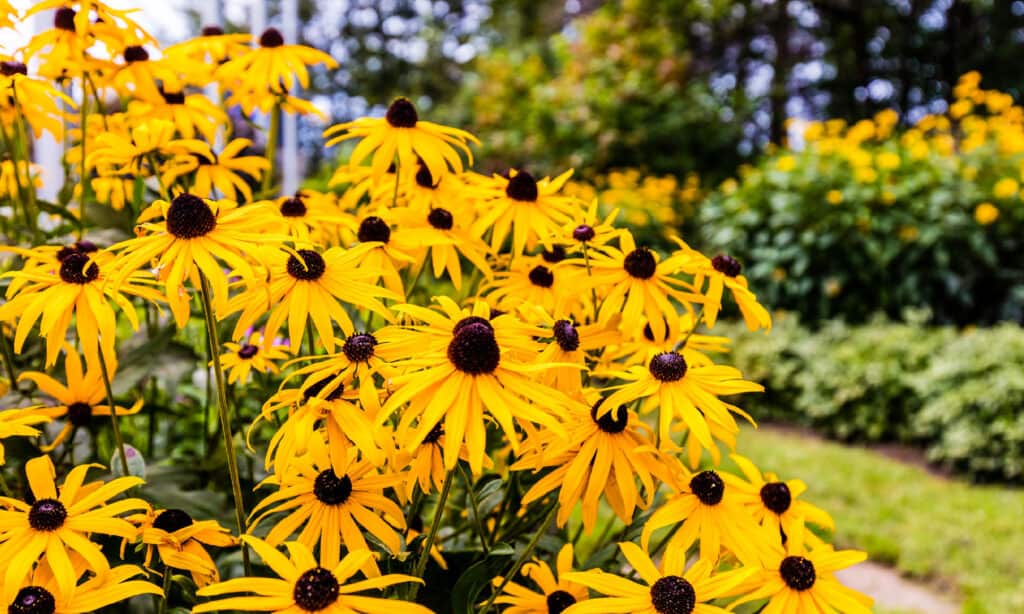
The black-eyed Susan is an easy-to-grow perennial flower that will reward you with hundreds of blooms.
©iStock.com/Dopeyden
Black-eyed Susan, scientifically known as Rudbeckia spp., is a flowering plant that belongs to the Aster family. This species of wildflower is native to North America and can be found across different regions in the United States. It typically grows up to 3 feet tall and has bright yellow or orange petals with dark brown centers, hence its name, “black-eyed Susan.”
Black-eyed Susan plants are known for their ability to attract pollinators such as bees and butterflies, making them an excellent addition to any garden landscape. They prefer full sun exposure but can tolerate partial shade, making them versatile enough for various growing conditions.
In terms of care requirements, black-eyed Susans are relatively low-maintenance plants that thrive in well-draining soil with moderate watering needs. They also have the ability to self-seed, which allows them to spread throughout the garden over time.
Overall, black-eyed Susans are beautiful and hardy flowers that offer many benefits beyond just aesthetic appeal. With their easy-to-grow nature, they make an excellent choice for both novice and experienced gardeners looking to add some color and vibrancy to their outdoor spaces.
Summary of 10 Wild Flowers To Fill Out Your Garden
| Number | Wildflower |
|---|---|
| 1 | Aster |
| 2 | Blanket Flower |
| 3 | Wild Blue Flax |
| 4 | Candytuft |
| 5 | Eastern Red Columbine |
| 6 | Coreopsis |
| 7 | Maximilian Sunflower |
| 8 | Blazing Star |
| 9 | Mexican Hat |
| 10 | Black-Eyed Susan |
The photo featured at the top of this post is © iStock.com/Natalya Mamaeva
Thank you for reading! Have some feedback for us? Contact the AZ Animals editorial team.







